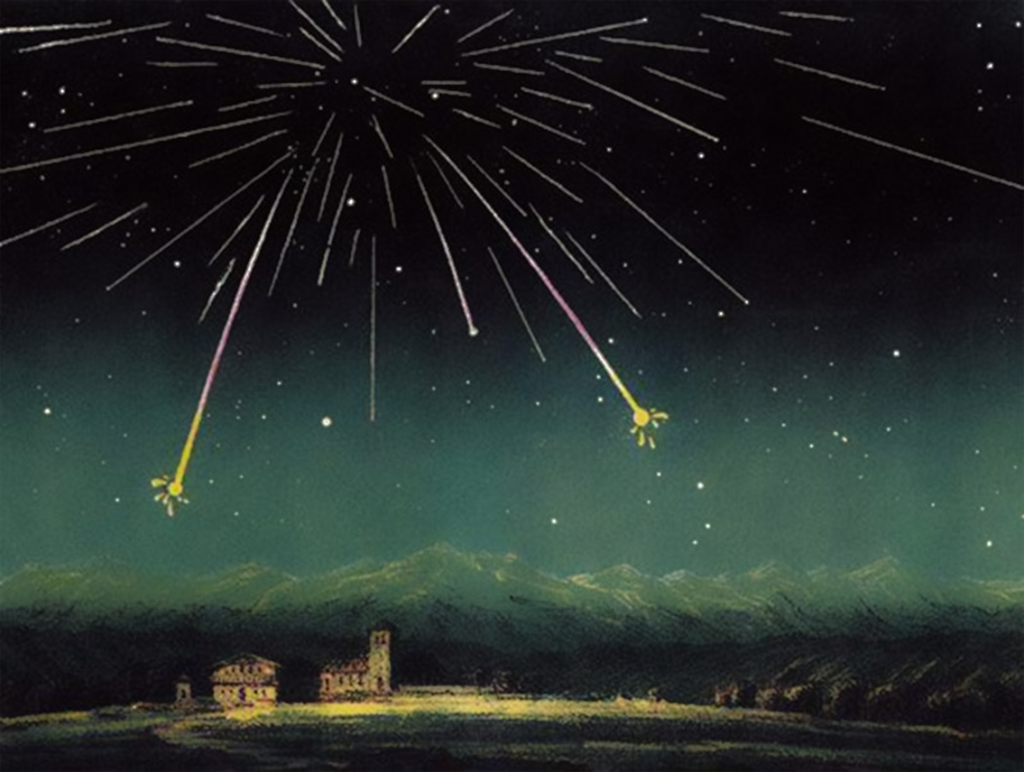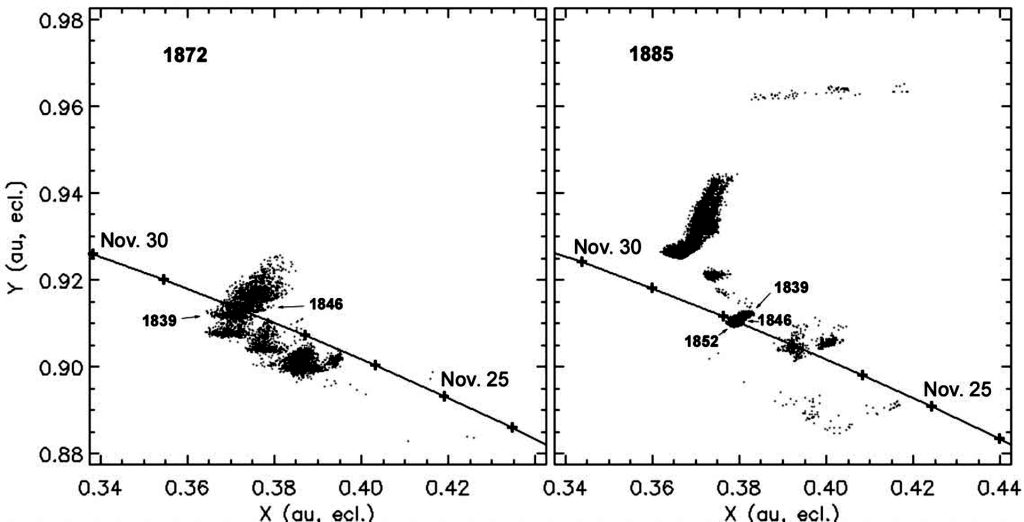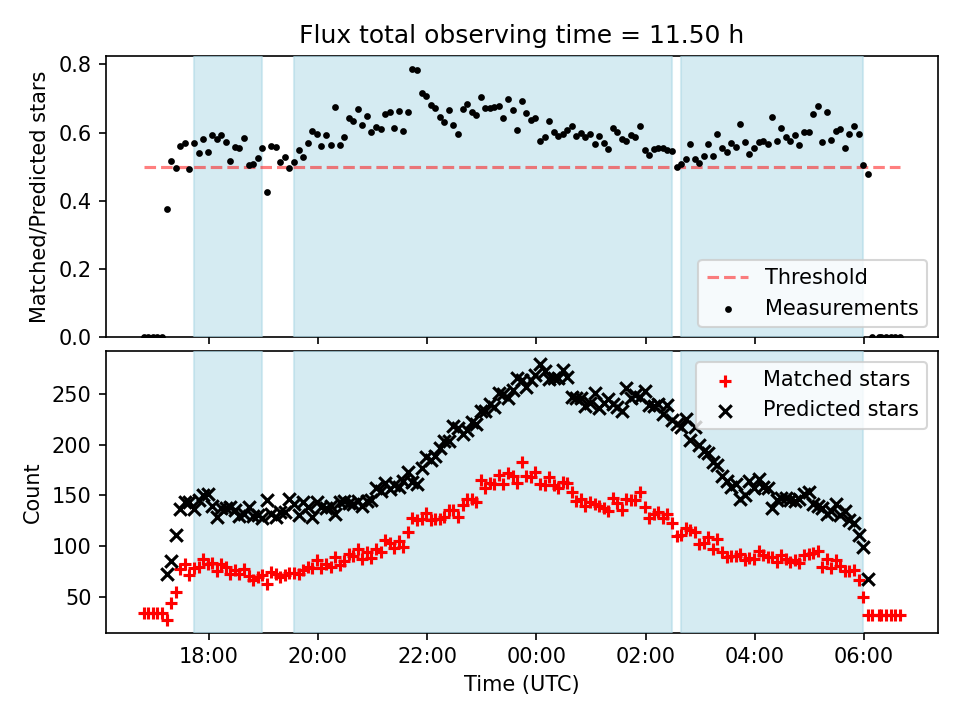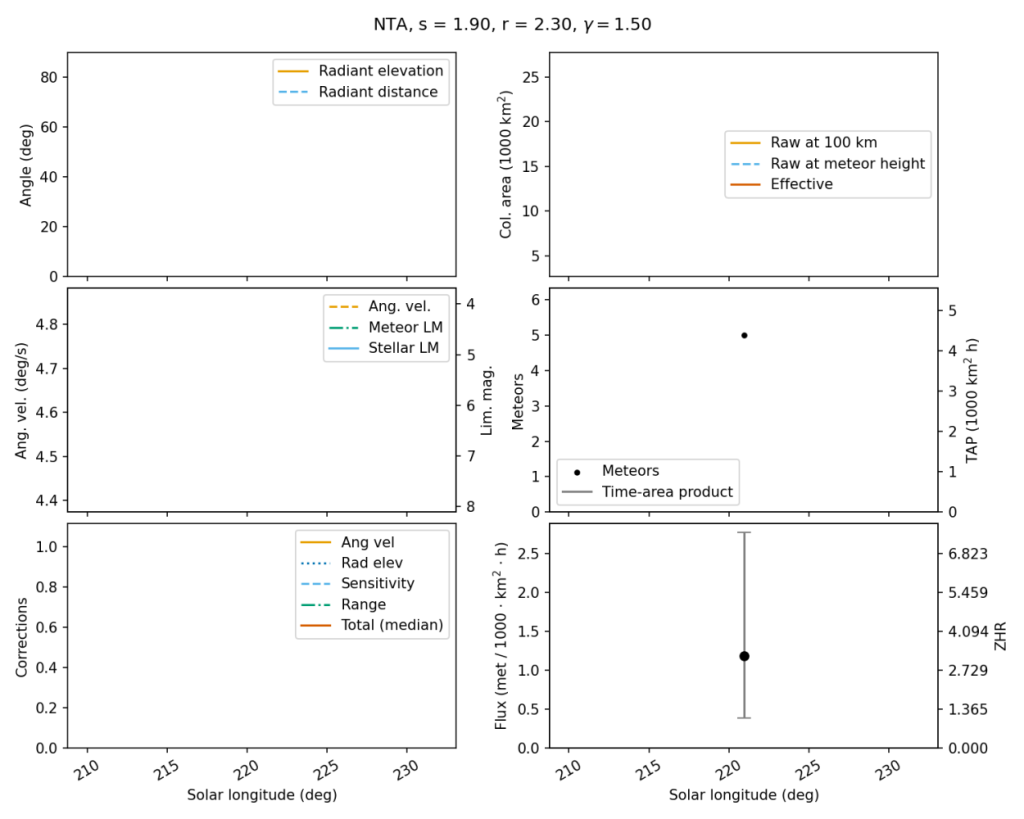2023 November 27
The Return of a ‘Lost’ Meteor Shower?
Each year we see a weak shower of meteors from a broad dust stream associated with disintegrated comet 3D/Biela. This Andromedid meteor shower is nothing much to get excited about. This year we may see much stronger activity associated with dust released from the comet in 1649. If modelling is correct the display could yield as many as 200 meteors an hour on the evening of December 2, surpassing even the Perseids and Geminids. These meteors will come from a different radiant than the annual Andromedids and observations are needed to help improve our knowledge of these streams.

Andromedid meteor storm as seen on the night of 1872 November 27 by Amédée Guillemin (Le Ciel, notions d’astronomie, à l’usage des gens du monde et de la jeunesse, 1864 and 1877).
On 27th November 1872 and on the same date in 1885, spectacular meteor storms were seen with an estimated peak zenithal hourly rate (ZHR) in excess of ~5,000 meteors per hour (m/h). On both occasions, activity was in excess of 1000 m/h for about 4 hours. In China, local observers wrote of the 1885 display that “…stars fell like rain from twilight until next dawn.” It was subsequently determined that these great displays were associated with the disintegration of the short-period comet 3D/Biela. This Jupiter-family comet was discovered by Jacques L. Montaigne (and independently by Charles Messier) in March 1772 and seen again in 1805 by Jean-Louis Pons. It wasn’t until its recovery in 1826 by Captain Wilhelm von Biela, who also calculated its orbit, that it was conclusively shown to be periodic with a period of about 6.7 years and identical to the comets seen in 1772 and 1805. At the time, it was only the third known periodic comet, after comets 1P/Halley and 2P/Encke. Biela’s comet returned as predicted in 1832, but the 1839 apparition was very unfavourable, and it wasn’t seen again until November 1845. At this apparition the comet was observed to have split in two and when it returned again in 1852 the two components had moved even further apart. Neither component was ever conclusively seen again.
A number of astronomers in the 19th Century proposed that the great meteor storms of 1872 and 1885 were connected with the disintegration of Biela’s comet (now known as 3D/Biela and the first ‘lost’ comet to carry the ‘D’ designation). In a 1982 paper by E.A. Reznikov (written in Russian), accounting for planetary perturbations on the individual meteoroids, the 1872 meteor storm was shown to be due to the dust trails laid down by the comet in 1839 and 1846 and that in 1885 due to the 1846 and 1852 dust trails. Subsequent work by J. Vaubaillon and P. Jenniskens confirmed Reznikov’s identifications. Probable returns of the shower associated with Biela’s comet date back to the mid-18th Century, but the shower has been weak or absent since the end of the 19th Century. The earliest showers peaked in very late November/early December and had radiants in Cassiopeia (RA 1h 20m, Decl. +50° to +60°). The later showers and particularly the great storms of 1872 and 1885 had radiants in Andromeda (RA 1h 48m, Decl. +44°) and this is why the shower is generally known as the Andromedids.

Key dust trails of comet 3D/Biela in 1872 and 1885. From: Meteor Showers and their Parent Comets, by Peter Jenniskens, Cambridge University Press, 2006, p383.
On 2011 December 3-5, the shower returned with a ZHR of ~50 m/h, the strongest return in over a century, with probable Andromedids detected by the Canadian Meteor Orbit Radar, the Southern Ontario Meteor Network and the Canadian Automated Meteor Observatory. At its observed peak at a solar longitude near λ☼ = 252◦.8 (2011 December 5 12 UT), the radiant was at RA = 18◦.2 (01h 13m), Decl. = +57◦.5, typical of the early Andromedids whose radiant was in Cassiopeia. The observed 2011 shower was comprised of predominantly small meteoroids (∼500 μm) with a slow geocentric speed (Vg = 16 km/s). Numerical simulations by Paul A. Wiegert et al. (Astron. J., 145 (3), 70 (2013)) (arXiv) indicated that they were primarily from the 1649 return of the parent comet, released long before the break-up. Further showers were also witnessed in late November/early December 2018 and 2021 and now there is a possibility of an even stronger Andromedid shower.
Based on their modelling of the 2011 outburst, Paul Wiegert’s team has predicted a strong naked-eye Andromedid outburst in December 2023 once again due to meteoroids released from 3D/Biela in 1649. If they are right, the display could yield as many as 200 meteors an hour, surpassing even the Perseids and Geminids. Such outbursts provide new data for numerical stream models and could help improve future predictions.
Key points
- The expected peak is at λ☼(2000.0) = 250°, equivalent to 2023 December 02, ~19h.
- BUT it is very important to observe on December 1/2 and December 2/3.
- Radiant at RA= 29° (1h 56m), Dec. +47°, between γ Andromedae and υ Persei.
- Shower members will be very slow, having a geocentric velocity of ~16 km/s.
- The waning gibbous Moon in Cancer rises around 21h local time, leaving a few hours undisturbed.
Important Note for Video Observers
Low rates of meteors coming from the (018 AND) radiant are detected by video meteor systems every year. GMN and SonotaCo UFO systems will have the 018 AND entries in their shower catalogues, but these radiants will be some way south of the radiant for this year’s predicted Andromedid shower. For those observers who contribute to the GMN network the predicted radiant has been added to the flux_showers.csv file and this will be updated on your cameras when the RMS software updates (by default this is every day). This will allow single station flux estimates which will be uploaded and displayed on the GMN flux page here:
https://globalmeteornetwork.org/flux/
Flux measurements are only made when the sky conditions are good and you should check your observing periods plots. On a good night you should get something like this:
 .
.
If meteors are detected and you have good skies the system will generate a flux plot (recent example for the Northern Taurids attached).

The multi-station orbit determination available a day or two after observing will show these meteors as sporadics but we will scan these files for potential candidates and will post information on the BAA website.
By whatever means you observe the Andromedids this year, please submit your results to the BAA Meteor Section via meteor@britastro.org. Good luck!
Dr John Mason
Director, BAA Meteor Section
email: meteor@britastro.org
2023 November 25
Resources
Presentation on the Bielids during Sky Notes at the October BAA meeting.
Presentation on the Bielids during July Comet Section meeting.
| The British Astronomical Association supports amateur astronomers around the UK and the rest of the world. Find out more about the BAA or join us. |
